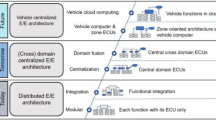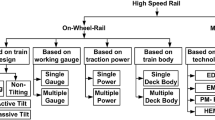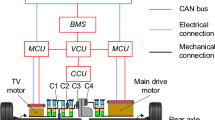Abstract
In-wheel vehicles driven by electrical energy are more efficient and emit less pollutant emissions than conventional vehicles powered by internal combustion engine. However, evaluation system for the in-wheel vehicles is not well established, the absence of the evaluation system for in-wheel vehicles is one of the major obstacles to commercialization of the in-wheel vehicles. In this study, we have suggested a new methodology of dynamometer test for in-wheel vehicle and devised simulators that can analyze the performance of in-wheel vehicles. In general, a new vehicle goes through the performance evaluation on dynamometer test which can simulate a straight motion of vehicles. Due to the characteristics of dynamometer test which simulates only a straight motion, it is not suitable for test for in-wheel vehicle. In the case of in-wheel vehicle, since driving motors on wheels are controlled independently, the stability of in-wheel vehicles during turning is important. Therefore, we have developed an in-wheel vehicle simulator to build a dynamometer test which can simulate turning motions of in-wheel vehicle. Using CarSim & Matlab/Simulink, we realized dynamic motion of a vehicle on a curved 3-demensional road. With this simulator, we could extract the load torque of each wheel during driving on the 3D virtual road. If the derived load torque is applied to motors of dynamometer test, it is possible to simulate driving on real road, through which the performance and the efficiency of in-wheel vehicles can be analyzed before the actual vehicle experiment. Also, we developed another simulator to evaluate the performance and the efficiency of in-wheel vehicles. This simulator allows us to evaluate the performance of in-wheel vehicles by using load torque derived from previous simulator. In this study, we developed two types of simulators to evaluate the performance of in-wheel vehicles in the simulation environment where the load torque for each wheel is different. One simulator derives load torque of each wheel and the other simulator evaluates the performance of in-wheel vehicles.
Similar content being viewed by others
Abbreviations
- V:
-
Total velocity at c.g. of vehicle, m/s
- R:
-
Turn radius of vehicle or radius of raod, m
- F:
-
Force, N
- x,y,z:
-
Longitudinal, lateral, vertical acceleration, m/s2
- Z:
-
Vertical length, m
- a:
-
Acceleration, m/s2
- m:
-
Total mass of vehicle, kg
- l:
-
Longitudinal distance from c.g., m
- C αf :
-
Cornering stiffness of front tire
- C ar :
-
Cornering stiffness of rear tire
- δ :
-
Steering wheel angle, rad
- I:
-
Moment of inertia, kg * m2
- ψ :
-
Yaw angle of vehicle, rad
- ψ :
-
Yaw rate of vehicle, rad/s
- ψ :
-
Yaw angular acceleration of vehicle, rad/s2
- C drag :
-
Air resistance coefficient
- A:
-
Frontal area, m2
- g:
-
Gravity, m/s2
- M y :
-
Torque, N * m
- hwc:
-
Height of wheel center, m
- l,r:
-
Left, right
- x,y,z:
-
Longitudinal, lateral, vertical
- w:
-
Width
- des:
-
Desired
- bk:
-
Brake
- res:
-
Resistance
References
Kim, N. W., Cha, S. W., and Peng, H., “Optimal Control of Hybrid Electric Vehicles Base on Pontryagin’s Minimum Principle,” IEEE Transactions on Control Systems Technology, Vol. 19, No. 5, pp. 1279–1287, 2011.
Kim, N. W., Cha, S. W., and Peng, H., “Optimal Equivalent Fuel Consumption for Hybrid Electric Vehicles,” IEEE Transactions on Control Systems Technology, Vol. 20, No. 3, pp. 817–825, 2012.
Zheng, C., Oh, C. E., Park, Y. I., and Cha, S. W., “Fuel Economy Evaluation of Fuel Cell Hybrid Vehicles Based on Equivalent Fuel Consumption,” International Journal of Hydrogen Energy, Vol. 37, No. 2, pp. 1790–1796, 2012.
Zheng, C., Cha, S. W., Park, Y. I., Lim, W., and Xu, G., “PMPBased Power Management Strategy of Fuel Cell Hybrid Vehicles Considering Multi-Objective Optimization,” Int. J. Precis. Eng. Manuf., Vol. 14, No. 5, pp. 845–853, 2013.
Zhang, J., Zheng, C., Cha, S. W., and Duan, S., “Co-State Variable Determination in Pontryagin’s Minimum Principle for Energy Management of Hybrid Vehicles,” Int. J. Precis. Eng. Manuf., Vol. 17, No. 9, pp. 1215–1222, 2016.
Choi, J., Jeong, J., Park, Y. I., and Cha, S. W., “Evaluation of Regenerative Braking Effect for E-REV Bus according to Characteristic of Driving Cycle,” Int. J. Precis. Eng. Manuf.-Green Tech., Vol. 2, No. 2, pp. 149–155, 2015.
Lee, H. S., Kim, J. S., Park, Y. I., and Cha, S. W., “Rule-Based Power Distribution in the Power Train of a Parallel Hybrid Tractor for Fuel Savings,” Int. J. Precis. Eng. Manuf.-Green Tech., Vol. 3, No. 3, pp. 231–237, 2016.
Zheng, C., Xu, G., Cha, S. W., Park, Y. I., and Lim, W., “PMP-based Power Management Strategy for Two-State Variable FCHV Systems and its Optimality,” Int. J. Precis. Eng. Manuf., Vol. 15, No. 4, pp. 769–776, 2014.
Zheng, C., Xu, G., Cha, S. W., and Liang, Q., “A Predictive Driving Control Strategy of Electric Vehicles for Energy Saving,” Int. J. Precis. Eng. Manuf., Vol. 16, No. 1, pp. 197–202, 2015.
Jeong, J., Lee, D., Kim, N., Zheng, C., Park, Y. I., et al., “Development of PMP-based Power Management for a Parallel Hybrid Electric Bus,” Int. J. Precis. Eng. Manuf., Vol. 15, No. 2, pp. 345–353, 2014.
Song, H. W., Lee, Y. K., Baek, J. J., Park, J. H., and Hwang, S. H., “Driving Force Distribution Algorithm for Improved Efficiency of 4-Wheel-Drive In-Wheel Electric vehicles,” Proc. of KSAE Spring Conference, pp.1846–1850, 2013.
Shin, S. and Choi, G., “Driving Performance Analysis of a Rear In-Wheel Motor Vehicle with Simultaneous Control of Driving Torque and Semi-Active Suspension System,” Transactions of KSAE, Vol. 23, No. 1, pp.11–17, 2015.
Hwang, Y., Nam, C., Yang, I., and Jeong, K., “Development and Validation of In-Wheel Vehicle Simulation Model,” Proc. of KSAE Annual Conference, pp. 2404–2408, 2012.
Fangjun, J. and Gao, Z., “An Application of Nonlinear PID Control to a Class of Truck ABS Problems,” Proc. of IEEE Decision and Control, Vol. 1, pp. 516–521, 2001.
Rajamani, R., “Vehicle Dynamics and Control,” Springer, 2nd Ed., 2013.
Jeong, J., Choi, J., Shin, C., Lim, W., and Cha, S. W., “Development of Control Algorithm for Wheel Motor Drive Bus System Considering Stability and Cornering Performance of Vehicle,” Proc. of KSAE Spring Conference, pp. 1445–1449, 2012.
Jeong, J., Choi, J., Shin, C., Lee, D., Lim, W., et al., “Development of Integrated Control Logic of Wheel Motor Drive Electric Bus Considering Stability and Driving Performance,” Transactions of KSAE, Vol. 21, No. 6, pp. 40–48, 2013.
Mechanical Simulation Corporation, “Powertrain_System,” VehicleSim Borwser Reference Manual, 2013.
Kim, N. W., Park, Y. I., Seo, H., Lee, D. H., and Cha, S. W., “A Backward Simulator for Calculating Optimal Control Trajectories,” Proc. of KSAE Spring Conference, pp. 1498–1503, 2009.
Author information
Authors and Affiliations
Corresponding author
Rights and permissions
About this article
Cite this article
Son, S., Song, C., Cha, S.W. et al. Novel Evaluation Systems for Compact In-Wheel Vehicles Considering Deviation of Load Torque between Left and Right Wheel. Int. J. of Precis. Eng. and Manuf.-Green Tech. 5, 287–294 (2018). https://doi.org/10.1007/s40684-018-0030-9
Received:
Revised:
Accepted:
Published:
Issue Date:
DOI: https://doi.org/10.1007/s40684-018-0030-9




